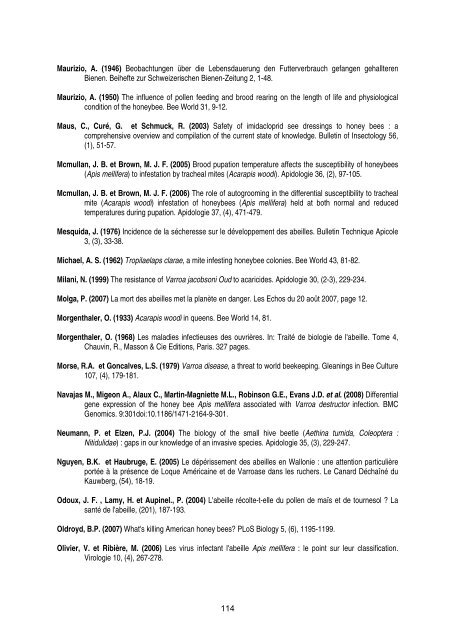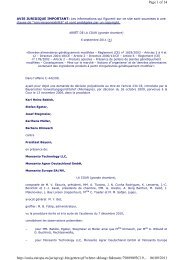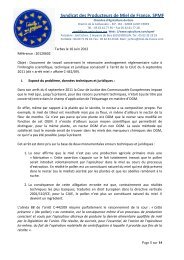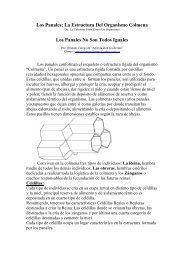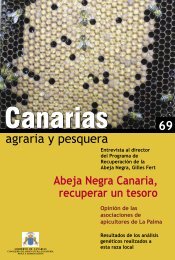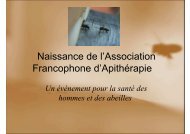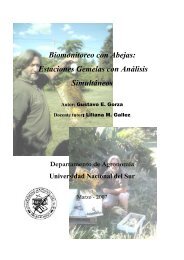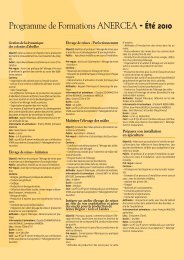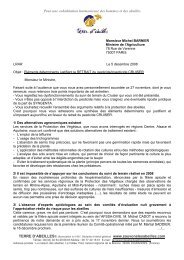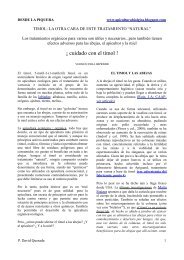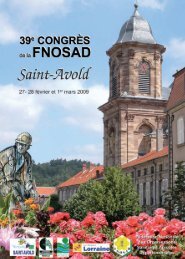Malone, L.A., Burgess, E.P.J., Christeller, J.T. <strong>et</strong> Gatehouse, H.S. (1998) In vivo responses of honey beemidgut proteases to protease inhibitors from potato. Journal of Insect Physiology 44, (2), 141-147.Malone, L. A. <strong>et</strong> Stefanovic, D. (1999) Comparison of the responses of two races of honeybees to infectionwith Nosema apis Zander. Apidologie 30, (5), 397-463.Malone, L.A. <strong>et</strong> Pham-Delegue, M.H. (2001) Effects of transgene products on honey bees and bumblebees.Apidologie 32, (4), 1-18.Malone, L.A., Gatehouse, H.S. <strong>et</strong> Tregidga, E.L. (2001) Effects of time, temperature, and honey on Nosemaapis (Microsporidia : Nosematidae), a parasite of the honeybee, Apis mellifera (Hymenoptera : Apidae).Journal of Invertebrate Pathology 77, (4), 258-268.Malone, L.A. (2004) Potential effects of GM crops on honey bee health. Bee World 85, (2), 29-36.Mangum, W.A. (1999) Honey bee biology ; clues to some causes of winter colony deaths. American BeeJournal 139, (2), 117-120.Maori, E., Lavi, S., Mozes-Koch, R., Gantman, Y., Per<strong>et</strong>z, Y., Edelbaum, O., <strong>et</strong> al. (2007) Isolation andcharacterization of Israeli acute paralysis virus, a dicistrovirus affecting honeybees in Israel: evidencefor diversity due to intra- and inter-species recombination. Journal of General Virology 88, (12), 3428-3438.Marshall, E.J.P., West, T.M. <strong>et</strong> Kleijn, D. (2006) Impacts of an agri-environment field margin prescription onthe flora and fauna of arable farmland in different landscapes. Agriculture, Ecosystems andEnvironment 113, (1-4), 36-44.Martel, A.C., Zeggane, S., Aurières, C., Drajnudel, P., Faucon, J.P. <strong>et</strong> Aubert, M. (2007) Acaricide residuesin honey and wax after treatment of honey bee <strong>colonies</strong> with Apivar or Asuntol50. Apidologie 38, (6),534-544.Marti, J.I., Cacho, E. , Del Josa, A., Espinosa, E. <strong>et</strong> Muino-Blanco, T. (1996) Plasma membraneglycoproteins of mature and immature drone honey bee (Apis mellifera L.) spermatozoa : lectin-bindingas seen by light and electron microscopy. Theriogenology 46, (1), 181-190.Martin, S. J. (1998) A population model of the ectoparasitic mite Varroa jacobsoni in honey bee (Apis mellifera)<strong>colonies</strong>. Ecological Modelling 109, (3), 267-281.Martin, S.J. (2004) Acaricid (pyr<strong>et</strong>hroid) resistance in Varroa <strong>des</strong>tructor. Bee World 4, (85), 67-69.Martín-Hernández, R., Meana, A., Pri<strong>et</strong>o, L., Martínez Salvador, A., Garrido-Bailón, E. <strong>et</strong> Higes, M. (2007)The outcome of the colonization of Apis mellifera by Nosema ceranae. Applied and EnvironmentalMicrobiology 73, ( 20), 6331-6338.Martin-Hernandez, R., Higès, Pérez, J.L., Nozal, J.L., Gomez, L. (2007) Short term effect of oxalic acid in Apismellifera iberiensis. Spanish journal of agricultural Research 5, (4), 474-480.Matheson, A. (1996) World bee health update. Bee World 77, (1), 45-51.Mathieu, L. <strong>et</strong> Faucon, J.P. (2000) Changes in the response time for Varroa jacobsoni exposed to amitraz.Journal of Apicultural Research 39, (3-4), 155-158.Mattila, H.R. <strong>et</strong> Otis, G.W. (2006) Effects of pollen availability and nosema infection during the spring ondivision of labour and survival of worker honey bees (Hymenoptera : Apidae). EnvironmentalEntomology 35, (3), 708-717.113
Maurizio, A. (1946) Beobachtungen über die Lebensdauerung den Futterverbrauch gefangen gehallterenBienen. Beihefte zur Schweizerischen Bienen-Zeitung 2, 1-48.Maurizio, A. (1950) The influence of pollen feeding and brood rearing on the length of life and physiologicalcondition of the honeybee. Bee World 31, 9-12.Maus, C., Curé, G. <strong>et</strong> Schmuck, R. (2003) Saf<strong>et</strong>y of imidacloprid see dressings to honey bees : acomprehensive overview and compilation of the current state of knowledge. Bull<strong>et</strong>in of Insectology 56,(1), 51-57.Mcmullan, J. B. <strong>et</strong> Brown, M. J. F. (2005) Brood pupation temperature affects the susceptibility of honeybees(Apis mellifera) to infestation by tracheal mites (Acarapis woodi). Apidologie 36, (2), 97-105.Mcmullan, J. B. <strong>et</strong> Brown, M. J. F. (2006) The role of autogrooming in the differential susceptibility to trachealmite (Acarapis woodi) infestation of honeybees (Apis mellifera) held at both normal and reducedtemperatures during pupation. Apidologie 37, (4), 471-479.Mesquida, J. (1976) Incidence de la sécheresse sur le développement <strong>des</strong> abeilles. Bull<strong>et</strong>in Technique Apicole3, (3), 33-38.Michael, A. S. (1962) Tropilaelaps clarae, a mite infesting honeybee <strong>colonies</strong>. Bee World 43, 81-82.Milani, N. (1999) The resistance of Varroa jacobsoni Oud to acarici<strong>des</strong>. Apidologie 30, (2-3), 229-234.Molga, P. (2007) La mort <strong>des</strong> abeilles m<strong>et</strong> la planète en danger. Les Echos du 20 août 2007, page 12.Morgenthaler, O. (1933) Acarapis woodi in queens. Bee World 14, 81.Morgenthaler, O. (1968) Les maladies infectieuses <strong>des</strong> ouvrières. In: Traité de biologie de l'abeille. Tome 4,Chauvin, R., Masson & Cie Editions, Paris. 327 pages.Morse, R.A. <strong>et</strong> Goncalves, L.S. (1979) Varroa disease, a threat to world beekeeping. Gleanings in Bee Culture107, (4), 179-181.Navajas M., Migeon A., Alaux C., Martin-Magni<strong>et</strong>te M.L., Robinson G.E., Evans J.D. <strong>et</strong> al. (2008) Differentialgene expression of the honey bee Apis mellifera associated with Varroa <strong>des</strong>tructor infection. BMCGenomics. 9:301doi:10.1186/1471-2164-9-301.Neumann, P. <strong>et</strong> Elzen, P.J. (2004) The biology of the small hive be<strong>et</strong>le (A<strong>et</strong>hina tumida, Coleoptera :Nitidulidae) : gaps in our knowledge of an invasive species. Apidologie 35, (3), 229-247.Nguyen, B.K. <strong>et</strong> Haubruge, E. (2005) Le dépérissement <strong>des</strong> abeilles en Wallonie : une attention particulièreportée à la présence de Loque Américaine <strong>et</strong> de Varroase dans les ruchers. Le Canard Déchaîné duKauwberg, (54), 18-19.Odoux, J. F. , Lamy, H. <strong>et</strong> Aupinel., P. (2004) L'abeille récolte-t-elle du pollen de maïs <strong>et</strong> de tournesol ? Lasanté de l'abeille, (201), 187-193.Oldroyd, B.P. (2007) What's killing American honey bees? PLoS Biology 5, (6), 1195-1199.Olivier, V. <strong>et</strong> Ribière, M. (2006) Les virus infectant l'abeille Apis mellifera : le point sur leur classification.Virologie 10, (4), 267-278.114
- Page 1:
Mortalités, effondrements et affai
- Page 4 and 5:
M. François MOUTOUEpidémiologie g
- Page 6 and 7:
SOMMAIRELISTE DES TABLEAUX ........
- Page 9:
RÉFÉRENCES BIBLIOGRAPHIQUES......
- Page 16 and 17:
INTRODUCTIONL’environnement et l
- Page 18 and 19:
Les membres de ce groupe de travail
- Page 20 and 21:
Figure 1 : Population théorique mo
- Page 22 and 23:
Figure 2 : Facteurs influençant l
- Page 24 and 25:
Pour le calcul du taux de mortalit
- Page 26 and 27:
Agent pathogèneVespa velutinaAethi
- Page 28 and 29:
Tableau 3 : Les douze principaux vi
- Page 30 and 31:
1.2.2 Agents chimiquesLes abeilles
- Page 32 and 33:
• L’exposition résultant de l
- Page 34 and 35:
- Au Royaume-Uni, d’après le WII
- Page 36 and 37:
Par leur nature, ces types d’inci
- Page 38 and 39:
Le taux de protéine contenu dans l
- Page 40 and 41:
Tableau 4 : Teneur en protéines br
- Page 42 and 43:
1.2.3.4 Pratiques agricolesÉvoluti
- Page 44 and 45:
En conditions de laboratoire, semi-
- Page 46 and 47:
- des conditions climatiques, alter
- Page 48 and 49:
2 SITUATION SANITAIRE DE LA FILIÈR
- Page 50 and 51:
2.2 LA FILIERE APICOLE FRANÇAISE2.
- Page 52 and 53:
2.2.2 Les difficultés de la filiè
- Page 54 and 55:
2.3 CAUSES DES MALADIES DES ABEILLE
- Page 56 and 57:
2.3.1.2 Publications et rapports sc
- Page 58 and 59:
Une étude consacrée aux viroses d
- Page 60 and 61:
2.3.2.2 Publications et rapports sc
- Page 62 and 63:
Des cas de mortalités anormales d
- Page 64 and 65: Les informations disponibles pour l
- Page 66 and 67: aux colonies, même si, en théorie
- Page 68 and 69: A l’issue de l’étude des cause
- Page 70 and 71: Figure 3 : Organisation des structu
- Page 72 and 73: Toutefois, pour plusieurs raisons,
- Page 74 and 75: Plus particulièrement dans le doma
- Page 76 and 77: 2.4.1.4 Rôle de la professionDiff
- Page 78 and 79: 2.4.1.5 La formation sanitaire apic
- Page 80 and 81: 2.4.2 La pharmacie vétérinaire du
- Page 82 and 83: 2.4.2.2 Le traitement des autres ma
- Page 84 and 85: 3 RECOMMANDATIONSUne classification
- Page 86 and 87: 3.1 ÉPIDÉMIOSURVEILLANCE 44 DES M
- Page 88 and 89: Dans ce schéma, les données serai
- Page 90 and 91: La mission prioritaire de cet insti
- Page 92 and 93: • Création d’un guide de bonne
- Page 94 and 95: 3.2.6.7 Mise en place d’un contr
- Page 96 and 97: - viser une application stricte, da
- Page 98 and 99: 3.4.3 Étiologie multifactorielle d
- Page 100 and 101: peuvent être particulièrement per
- Page 102 and 103: CONCLUSIONLa réflexion menée au s
- Page 104 and 105: Anderson, D.L. et Trueman, J.W. (20
- Page 106 and 107: Bruderer, C. et Hermieu, Y. (2008)
- Page 108 and 109: De Jong, D., Morse, R.A. et Eickwor
- Page 110 and 111: Faucon, J.P. et Chauzat, M. P. (200
- Page 112 and 113: Imdorf, A. et Gezig, L. (1999) Guid
- Page 116 and 117: Ongus, J.R., Peters, D., Bonmatin,
- Page 118 and 119: Rothenbuhler, W.C. (1964) Behaviour
- Page 120 and 121: Wahl, O. et Ulm, K. (1983) Influenc
- Page 122 and 123: 121
- Page 124 and 125: • Aethina tumidaNom commun : le p
- Page 126 and 127: (Bailey et Ball, 1991). Les princip
- Page 128 and 129: pertes de colonies dans l’ensembl
- Page 130 and 131: Pour les vétérinaires spécialis
- Page 132 and 133: La dispersion des spores s’effect
- Page 134 and 135: Elle serait due au développement d
- Page 136 and 137: 5.3) Les virus sans association ave
- Page 138 and 139: d’échantillons de cas de CCD (30
- Page 140: consécutifs à chacun des usages p
- Page 143 and 144: Figure 10 (annexe 3) : Schéma d’
- Page 145 and 146: de ceux qui ne le sont pas, afin d
- Page 147 and 148: L’évaluation des risques a été
- Page 149 and 150: Figure 12 (annexe 4) : Carte des r
- Page 151 and 152: Figure 14 (annexe 4) : Exemples de
- Page 153 and 154: ANNEXE 6 : Estimation des pertes de
- Page 155: 154


